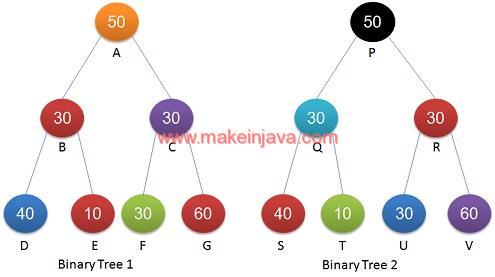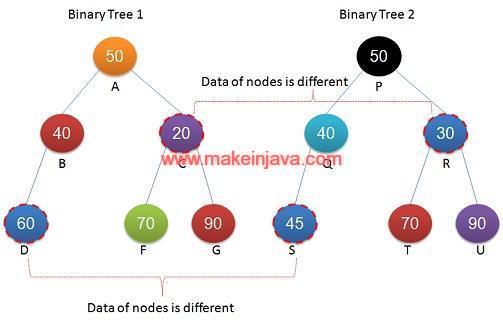- Given two binary trees, find out whether one binary tree is equal or identical or same to another binary tree.
- Traverse the binary trees using depth first search (DFS) recursive algorithm
- What identical binary tree?
- Composition of binary trees should be same.
- Data nodes of binary trees (at respective position) should be same.
- We have discussed similar problem to check given binary tree is mirror of another binary tree.
Examples to check binary trees are equal or identical
Example 1: Identical or Same binary trees (Fig 1)
- Structure of both the trees is same
- Data nodes of corresponding binary trees are same.

Example 2: Non-Identical binary trees (Fig 2)
- Structure of both the trees is same
- Data nodes of corresponding binary trees are NOT same.
- Node C and Node R has different values.
- Node D and Node S has different values.

Algorithm to check binary trees are identical
- Check both nodes of both tree1 and tree2
- If tree1 and tree2 is null, tree traversal completed successfully.
- return true
- If node of any of tree is null.
- Trees are not identical, return false .
- Compare data of tree1 and tree2
- Data is same for both nodes
- Go through Left subtree and right subtree
- Traverse Left child of binary tree1 and left child of tree2
- Traverse Right child of binary tree1 and right child of tree2
- Go through Left subtree and right subtree
- Data is not same
- Trees are not identical, return false
- Data is same for both nodes
- After above traversal, we will know whether binary trees are identical or equal or same.
- Time Complexity:
- Let tree1 contains p number of nodes & tree2 contains q number of nodes.
- Time Complexity: O(p) where p > q
Program – Check binary tree is identical to another binary tree:
1.) BinaryTreesAreSame class: BinaryTreesAreSame class is responsible for checking binary trees are identical or same or equal using recursive algorithm.
package org.learn.Question;
import org.learn.PrepareTree.Node;
public class BinaryTreesAreSame {
public static boolean isSameBinaryTree(Node tree1, Node tree2) {
if (tree1 == null && tree2 == null) {
return true;
}
if (tree1 == null || tree2 == null) {
return false;
}
if (tree1.data != tree2.data)
return false;
if (false == isSameBinaryTree(tree1.left, tree2.left))
return false;
if (false == isSameBinaryTree(tree1.right, tree2.right))
return false;
return true;
}
}
2) App Class:
- We are constructing the Binary Tree in main method.
- We are calling BinaryTreesAreSame.isSameBinaryTree, to check both binary trees are identical or equal or same.
package org.learn.Client;
import org.learn.PrepareTree.Node;
import org.learn.Question.BinaryTreesAreSame;
public class App
{
public static void main( String[] args )
{
Node tree1 = Node.createNode(50);
tree1.left = Node.createNode(30);
tree1.right = Node.createNode(30);
// left sub tree
tree1.left.left = Node.createNode(40);
tree1.left.right = Node.createNode(10);
// right subtree
tree1.right.left = Node.createNode(30);
tree1.right.right = Node.createNode(60);
Node tree2 = Node.createNode(50);
tree2.left = Node.createNode(30);
tree2.right = Node.createNode(30);
// left sub tree
tree2.left.left = Node.createNode(40);
tree2.left.right = Node.createNode(10);
// right subtree
tree2.right.left = Node.createNode(30);
tree2.right.right = Node.createNode(60);
boolean isSame = BinaryTreesAreSame.isSameBinaryTree(tree1, tree2);
if(isSame) {
System.out.println("Trees are identical");
} else {
System.out.println("Trees are not identical");
}
}
}
3.) Node Class: Node class representing the nodes of Binary Tree.
package org.learn.PrepareTree;
public class Node {
public int data;
public Node left;
public Node right;
public Node(int num) {
this.data = num;
this.left = null;
this.right = null;
}
public Node() {
this.left = null;
this.right = null;
}
public static Node createNode(int number) {
return new Node(number);
}
}
Output – Check binary trees are same (Fig 1)
Trees are identical
Download Code – Check Binary Trees are Identical or Same
